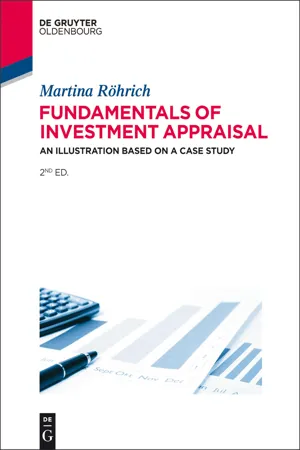Economics
Present Value Calculation
Present value calculation is a method used to determine the current worth of a future sum of money, taking into account the time value of money. It involves discounting future cash flows back to the present using a discount rate. This allows for comparing the value of money received or paid at different points in time.
Written by Perlego with AI-assistance
Related key terms
Related key terms
1 of 4
Related key terms
1 of 3
12 Key excerpts on "Present Value Calculation"
- eBook - ePub
Applied Equity Analysis and Portfolio Management
Tools to Analyze and Manage Your Stock Portfolio
- Robert A. Weigand(Author)
- 2014(Publication Date)
- Wiley(Publisher)
Figure A1.7 :(A1.11)FIGURE A1.7 The Basic Present Value Tool.FIGURE A1.8 Example 1: Economic Equivalence.The operation is called discounting because, at any positive interest rate, the present value of the expected future cash flow will be less than its future value. This occurs because interest rates take an investor's cost of waiting into account—if the investor could take possession of the money sooner, they could invest it sooner. The value of expected future cash flows is therefore reduced by the opportunity cost of having to wait for the cash flow, rather than having it available for productive investment now.Economic Equivalence If you expect to receive $50,000 in one year and the discount rate is 9 percent, how much is the expected cash flow worth in terms of dollars today?(A1.12)The calculation depicts an important valuation concept in finance: $50,000 received in one year and $45,872 today are economically equivalent (at a discount rate of 9 percent). The reason for this is that a person who had $45,872 today could invest it at 9 percent and grow it to $50,000 in one year. Notice that $45,872 today and $50,000 in one year are also equivalent to receiving $54,500 in two years. By similar reasoning, someone who had $45,872 today could invest it for two years at 9 percent and grow it to $54,500, as depicted in Equation A1.13 and Figure A1.8 - eBook - ePub
Pipeline Rules of Thumb Handbook
A Manual of Quick, Accurate Solutions to Everyday Pipeline Engineering Problems
- M.J. Kaiser, E.W. McAllister(Authors)
- 2022(Publication Date)
- Gulf Professional Publishing(Publisher)
opportunity cost of capital. It represents the opportunity cost (rate of return) foregone by making this particular investment rather than other alternatives of comparable risk.The formula for calculating present value is:where PV = Present value, FV = Future value,r = Discount rate (per compounding period), andn = Number of compounding periods.Example
What is the present value of an investment that guarantees to pay you $100,000 three years from now? The first important step is to understand what risks are involved in this investment, and then choose a discount rate equal to the rate of return on investments of comparable risk. Let's say you decide that 9% effective annual rate of interest (9% compounded annually) is an appropriate discount rate.Thus, you would be willing to invest $77,218 today in this investment to receive $100,000 in 3 years.Future value of a single investment
Rearranging the relationship between PV and FV, we have a simple formula to allow us to calculate the future value of an amount of money invested today:where FV = Future value, PV = Present value, R = Rate of return (per compounding period), and n = Number of compounding periods.Example
What is the future value of a single $10,000 lump sum invested at a rate of return of 10% compounded monthly (10.47 effective annual rate) for 5 years? Note that monthly compounding is used in this example.The $10,000 investment grows to $16,453 in 5 years.The importance of cash flow diagrams
Many financial problems are not nearly as simple as the two previous examples, which involved only one cash outflow and one cash inflow. To help analyze financial problems, it is extremely useful to diagram cash flows, since most problems are considerably more complex than these previous examples and may have multiple, repetitive, or irregular cash flows. The cash flow diagram - Ivan E Brick(Author)
- 2017(Publication Date)
- WSPC(Publisher)
CHAPTER 2TIME VALUE OF MONEY
The Time Value of Money
The value of money a year from now is less than the value of that money today. Why is that? The reason is that you can invest money today and hopefully receive a larger amount in the future. Since money has a time value associated with it, financial analysts must consider the present value (PV) of future cash flows when they are making financial decisions.Learning how to take present value of future cash flows is one of the most important lessons in finance. Why? As we will discuss later, the price of any asset is the present value of its cash flows. Moreover, present value provides the framework that allows managers to rank competing capital projects and to help determine the cheapest source of financing.Finding the Present Value of Future Cash Flows
Imagine that our bank is willing to offer us 10% interest on a $100 deposit. At the end of the year the future value (FV) of our investment should be our initial investment of $100 plus the promised interest of 10% on our investment or $110. Another way of saying this is that the promised future value of $110 one year from now has a present value of $100 today. In fact, an investor should be indifferent from receiving $100 today or $110 one year from now because the investor is able to invest $100 today at an interest rate of 10% and receive $110 at the end of the year.Let us analyze our problem more closely so that we can generalize the relationship between present value and future value. We made the observation that if we invested $100 at 10% it will be worth $110 at the end of year 1. That is, we will receive our original investment of $100 and interest of 10% of that $100. Mathematically this is written as:$100(1.1) = $110. By dividing both sides of that equation by 1.1 we find the present value of the $110 or PV = $110/(1.1) = $100. The more general mathematical formula for PV is given by:where CFT is the cash flow at time T and R is the interest rate. In the example above, R is the annual interest of 10%. In our example, T- eBook - ePub
- (Author)
- 2002(Publication Date)
- Harvard Business Review Press(Publisher)
The PVIF table clearly indicates how the present value of money received in the future shrinks with time. Scan any discount rate column in the PVIF table from top to bottom. The first number is the value of $1 received a year from now. In the 10 percent column, that value is $0.91. The same dollar is worth only $0.39 if you must wait ten years to get your hands on it. Strictly chump change. Notice, too, the role that the discount rate plays in shrinking future values over time. At 6 percent, $1 received ten years from now is worth $0.59. But at a discount rate of 12 percent, that same dollar is down to a mere $0.32! Thus, present value “shrinkage” has two sources: time and the discount rate. The greater the time and the higher the rate, the less your future cash flows will be worth.TABLE 9-3Present Value of $1 (PVIF)Your financial calculator and PC spreadsheet can handle this same calculation. You simply enter the known values (future value, discount rate, and number of compounding periods) and solve for the unknown value, PV.Now that you understand present value, let’s move on to a typical business situation and see how time-value calculations can help your decision making. But first let’s broaden the concept of present value to net present value (NPV), which is the present value of one or more future cash flows less any initial investment costs. To illustrate this concept, let’s say that Amalgamated Hat Rack expects its new product line to start generating $70,000 in annual profit (or, more specifically, net cash flows) beginning one year from now. For simplicity, we’ll also say that this level of annual profit will continue for the succeeding five years (totaling $350,000). Bringing the product line on stream will require an up-front investment of $250,00. The questions for the company can thus be phrased as follows: Given this expected profit stream and the $250,000 up-front cost required to produce it, is a new line of coat racks the most productive way to invest that initial $250,000? Or would Amalgamated be better off investing it in something else?A net-present-value calculation answers this question by recognizing that the $350,000 in profit that Amalgamated expects to receive over five years is not worth $350,000 in current dollars. Because of the time value of money, it is worth less than that. In other words, that future sum of $350,000 has to be discounted back into an equivalent of today’s dollars. How much it is discounted depends on the rate of return Amalgamated could reasonably expect to receive had it chosen to put the initial $250,000 investment into something other than the line of coat racks (but similar in risk) for the same period. As explained earlier, this rate of return is often called the discount rate. We define the discount rate as the annual rate, expressed as a percentage, at which a future payment or series of payments is reduced to its present value. In our Amalgamated example, let’s assume a discount rate of 10 percent. But before we describe the calculation, let’s lay out the situation as follows, with the values in thousands of dollars: - Daniel Adrian Doss, William H. Sumrall III, Don W. Jones(Authors)
- 2017(Publication Date)
- Routledge(Publisher)
Some initiatives may require periods that are longer than those that are considered within this text. When these situations occur, it is recommended that NPV calculations be performed through the use of software spreadsheets, proprietary software, or financial calculators. Also, within the context of collegiate finance courses, a tabular solution is also available to solve NPV problems involving a variety of periods. However, for the purposes of this text, the use of the basic formula is appropriate to demonstrate the basic concept of net present value and to delineate the calculations through which NPV problems are solved. Future editions of this text, if any, are anticipated to contain the tabular solution methods of NPV problems.6.8 Chapter Comments and Summary
This chapter introduced the net present value (NPV) method of capital budgeting. The methods of capital budgeting encompass perspectives of time, cash value, rate, and profitability potential. The NPV is indicative of a cash perspective regarding the rendering of capital budgeting decisions. Further, the NPV method incorporates the time value of money within its primary construct. Derivation of the NPV method can occur through algebraic manipulation of the current monetary value formula given in Chapter 4 .The NPV method involves a consideration of the anticipated cash flows of a capital investment through time. These anticipated future values are discounted to determine their current monetary equivalencies. Conceptually, the NPV is the sum of the present monetary value of the anticipated future cash flows of a potential capital investment excluding the costs of investment. Therefore, the NPV method provides a cash-based perspective regarding capital budgeting initiatives. The NPV may be used as a solitary method of capital budgeting or may be used in conjunction with any (or all) of the capital budgeting methods described within this text. The NPV method may be used to examine single capital initiatives or multiple capital initiatives. Further, this method may be used with or without the constraints imposed by mutual exclusion conditions.- eBook - ePub
The Essentials of Financial Modeling in Excel
A Concise Guide to Concepts and Methods
- Michael Rees(Author)
- 2023(Publication Date)
- Wiley(Publisher)
- It enables the results to be conceived of in a relative sense that is not as easy with future values (e.g. one immediately knows how much $100 today is worth, but it may be harder to have an immediate view on what $500 in 50 years' time is really worth).
- There are many possible future time points that could be used as reference points. Cash flows received before this point would need to be inflated, whereas those received afterwards would need to be discounted, thus adding complexity.
- The conversion of future values to present value terms highlights more clearly the possibility of risk or uncertainty that may be associated with the future values (such as a default by the counterparty or the general uncertainty associated with a business investment project). On the other hand, when inflating a known investment made today one may overlook or de‐emphasize such risks. Normally an investor and lender would want to be compensated for such uncertainty.
14.3 CALCULATION OPTIONS FOR PRESENT VALUES
In a sense, discounting is the reverse process to that of applying an interest rate (or inflating or growing the items). A discount rate (or a profile of discount rates that change over time) can be used either to inflate current values to future terms or to discount future values to their present value.Figure 14.1 shows a profile of cash flows in which each item is expressed in the nominal terms of the time point at which it occurs. For the moment, we also assume that the cash flows occur at the end of each period.In order to be able to express these items in present (or future) value terms, we need to know the time profile of discount rates. Figure 14.2 - Stephan Leimberg, Robert J. Doyle, Michael S. Jackson, Martin J Satinsky(Authors)
- 2019(Publication Date)
- The National Underwriter Company(Publisher)
The difficulty with this method arises with respect to what discount rate one should use in computing the present values of the cash inflows and cash outflows? Usually this discount rate will be the minimal acceptable rate of return. One usually finds this is rate by determining the cost of capital or, as in the example above, determining the rate an alternative investment of similar quality can earn. In the example above, the rate was 10 percent. Once one determines this so-called reinvestment rate, one can use it as the discount factor to compute the present value of the money invested and the present value of the expected return.Once one computes these present value amounts, one then nets them against each other. If the result is positive, the investment will exceed the reinvestment rate and one should seriously consider making the investment. If the net present value is a negative number and falls short of the reinvestment rate, the one generally reject the investment under consideration.An example of the use of net present value analysis may be helpful.To the extent that a proposed investment yields a positive net present value, the investment provides a potential cushion for safety. It also may allow the investor to incur certain additional costs, such as attorney’s, accountant’s, or financial planner’s fees in connection with the analysis of the investment, and still achieve the desired reinvestment rate.Assume that at the beginning of the year an individual has been shown an investment opportunity requiring a lump sum outlay of $10,000. Currently the funds he would use for this investment are in a bond fund earning 6 percent annually, net after taxes. The investment proposal projects the following after-tax cash flows at the end of each year.
Based solely on net present value analysis, should the investor make this investment?YearAmountReceived1 $ 2,000 2 1,500 3 750 4 500 5 10,000 TOTAL RECEIPTS$14,750- eBook - ePub
The Capital Budgeting Decision
Economic Analysis of Investment Projects
- Harold Bierman, Jr., Seymour Smidt(Authors)
- 2012(Publication Date)
- Routledge(Publisher)
Chapter 2The Time Value of Money
The frenetic buying of Internet stocks is going to make the tulip buyers of the 17th century look like value players.Rick Berry, director of equity research at J. P. Turner &Company in Atlanta. The New York Times, January 9, 1999Compound interest is one of the wonders of this world. It is the basis of the Present Value Calculations. The Safra Bank issued bonds that mature in 1,000 years. The present value of $1,000,000,000 of principal payments of this bond at a 0.08 annual interest rate is much less than $0.01. Compound interest is very powerful. A future sum may have a very small present value. A very small present amount might grow to a large sum in the future.To better understand the time value of money, we shall first assume that both the discount rate and the dollar amounts are known with certainty. These assumptions enable us to establish basic mathematical relationships and to compute exact relationships between future sums and their present values.Time Discounting
One of the basic concepts of business economics and managerial decision-making is that the present value of an amount of money is a function of the time of receipt or disbursement of the cash. A dollar received today is more valuable than a dollar to be received in some future time period. The only requirement for this concept to be valid is that there be a positive rate of interest at which funds can be invested or borrowed.The time value of money affects a wide range of business decisions, and how to incorporate time value considerations systematically into a decision is essential to an understanding of finance. The objective of this chapter is to develop skills in finding the present equivalent of a future amount or future amounts and the future equivalent of a present amount.Symbols Used
X Cash flow. If X is greater than zero there is a cash inflow. If X is less than zero, there is a cash outflow. t Time index. It can refer to a point in time or an interval (for example, t - eBook - ePub
Managerial Accounting
Tools for Business Decision Making, International Adaptation
- Jerry J. Weygandt, Paul D. Kimmel, Jill E. Mitchell(Authors)
- 2023(Publication Date)
- Wiley(Publisher)
The decision to make long-term capital investments is best evaluated using discounting techniques that recognize the time value of money. To do this, many companies calculate the present value of the cash flows involved in a capital investment.To illustrate, Dover-Calais Trucking Company, a cross-country freight carrier is considering adding another truck to its fleet because of a purchasing opportunity. Kent International, Dover-Calais’s primary supplier of overland rigs, is overstocked and offers to sell its biggest rig for €154,000 cash payable upon delivery. Dover-Calais knows that the rig will produce a net cash flow per year of €40,000 for five years (received at the end of each year), at which time it will be sold for an estimated salvage value of €35,000. Dover-Calais’s discount rate in evaluating capital expenditures is 10%. Should Dover-Calais commit to the purchase of this rig?The cash flows that must be discounted to present value by Dover-Calais are as follows:- Cash payable on delivery (today): €154,000.
- Net cash flow from operating the rig: €40,000 for five years (at the end of each year).
- Cash received from sale of rig at the end of five years: €35,000.
- eBook - ePub
- Brümmer LM, Hall JH, Du Toit E(Authors)
- 2017(Publication Date)
- Van Schaik Publishers(Publisher)
criterion is whether the discounted future sum has a higher value than the initial cost or principal of the investment as it stands at present. If the discounted income is less than the initial cost, a loss will result and the investment is best avoided. If the discounted income is greater than the cost of the investment, the investment should be a profitable one.The decision to invest is made easier when the fundamentals of the present value formula are extended to create another formula, namely the net present value (NPV) formula. In this section, we shall extend the present value formula so that it may be applied in the NPV method of investment analysis. In this book, any reference to investments would include those such as the purchase of fixed assets, or an additional project such as another business, and investing in shares.The present value formula
In the previous section, we derived the future value formula as:If we now wish to determine the present value (PV), then by algebraic transposition we would get:FV = PV(1 + k )nPV=FV( 1 + k )n= FV ×1( 1 + k )nThe expressionis used to calculate the discount factor or present value factor (PVF). This factor, multiplied by the future value of a certain sum of money, will then give the present value of that future sum.1( 1 + k )nLet us suppose that we have a future sum of R100 due in three years’ time, and that we want to determine what that sum is worth at present. Let us suppose further that the opportunity cost of capital is 10%, which is the rate we must use as our discount rate. Substituting these values into the PV formula, we get:= R100 ×1( 1 + 0.10 )3Now, the PVF is calculated in the same way as the compounding factor except that, in terms of the formula, the compounding or future value factor must be 156 divided into 1 each time a present value factor is calculated. Therefore, the discounting factor for three years at 10% is calculated as follows.We found previously that the compounding factor of (1 + 0.10)3 - eBook - ePub
Finance for IT Decision Makers
A practical handbook
- Michael Blackstaff(Author)
- 2012(Publication Date)
- BCS, The Chartered Institute for IT(Publisher)
The cost of capital will change over time. Old loans will be paid off and new ones taken out. More shares may be issued or shares may be bought back by companies with surplus cash. Market expectations of the return required from shares generally will change in line with changes to market interest rates and other economic factors. Expectations of the return required from particular shares may change as views of their risk change.Should these expected variations not be taken into account in evaluations (such as NPV evaluations) that involve the cost of capital? In theory, yes. In practice, however, especially over the relatively short evaluation periods chosen for most IT projects, they are nearly always ignored. Today’s cost of capital, and the discount rate derived from it, is usually deemed to apply for the whole period of the evaluation.APPLYING PRESENT VALUESWe are now in a position to work out the net present value (NPV) of the investment whose cash flows we estimated in Example 4.1. In doing so, we shall assume that the before-tax discount rate to be applied to the cash flows is 10 per cent. This is chosen purely to be a convenient number to work with. Table 5.1 shows the answer. If you wish to work it out for yourself, then use the discount table called Table A1.1 in Appendix 1 . Referring to the discount table, simply look up the 10 per cent discount factors for one, two, three and four years respectively. Enter them in the appropriate columns and then multiply the cash flows by the discount factors to arrive at the present values for each year. Finally, add all the present values to arrive at the ‘net present value’ to go into the total column. Figure 5.1 shows the discounted cash flows diagrammatically.A common mistake in doing these calculations is to forget that ‘Year 0’ is taken as meaning ‘today’, in respect of which the discount factor is of course 1.0. It is only future cash flows that are discounted. Remember that the term ‘net present value’ (NPV) is used because it refers to the sum of a series of individual present values, some of which are positive and some negative. - eBook - ePub
- Martina Röhrich(Author)
- 2014(Publication Date)
- De Gruyter Oldenbourg(Publisher)
0 . The net present value approach should be preferred to the internal rate of return because of its reinvestment assumption. Despite the superiority of the net present value approach other criteria are not completely irrelevant and useless. They may be used as supplementary measures to facilitate decision-making.- – The following were the main points covered:
- – A pre-condition for a useful application of discounting investment appraisal techniques is the possibility to identify all relevant cash flows.
- – Problems arise if interdependencies with the company’s environment exist, e. g. if it is not possible to isolate the outcomes of the investment.
- – So far, we have not considered qualitative investment assessment criteria.
- – Up to this point all techniques presented are based on certain estimates about the input data.
- – In the following chapters we introduce uncertainty as well as qualitative investment assessment criteria. Furthermore we integrate the effects of taxation, inflation and financing the investment if the borrowing and the lending interest rates are not equal. The simplifying assumptions under which the discounting methods of investment appraisal were introduced are put aside step by step.
3.8 Exercises with Answers
3.8.1 Exercises
Exercise 3-1 Basics of the discounting methods of investment appraisal- a) At the beginning of year 1 you can invest € 5,000. If the interest rate is 8 % per annum, how much will you get at the end of year 6?
- b) Suppose in three years you would need the sum of € 250,000 to buy land. Money could be left on deposit at an interest rate of 7 %. How much do you have to invest today?
Index pages curate the most relevant extracts from our library of academic textbooks. They’ve been created using an in-house natural language model (NLM), each adding context and meaning to key research topics.
Explore more topic indexes
Explore more topic indexes
1 of 6
Explore more topic indexes
1 of 4











